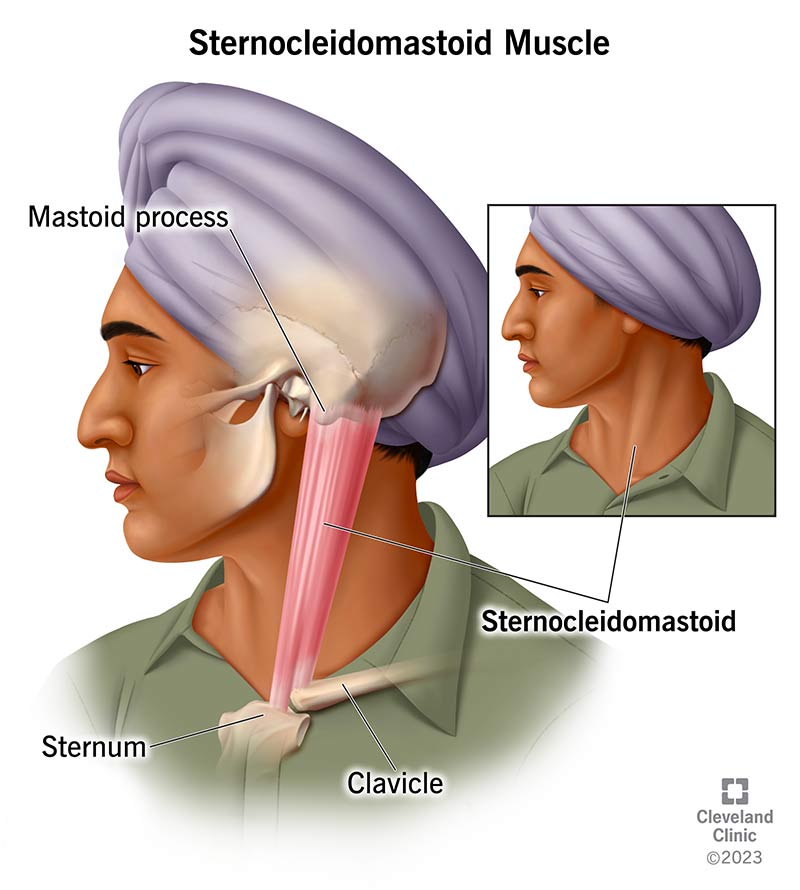Your sternocleidomastoid (SCM) muscle is a powerful neck muscle that allows you to bend your neck and turn or tilt your head. Injuries and tension within your SCM can lead to pain and stiffness. Treatments include stretching, physical therapy and osteopathic manipulation. You can care for your SCM by managing stress and maintaining good posture.
Advertisement
Cleveland Clinic is a non-profit academic medical center. Advertising on our site helps support our mission. We do not endorse non-Cleveland Clinic products or services. Policy

The sternocleidomastoid muscle (pronounced “stur-nuh-klai-duh-MAA-stoyd”) is the largest muscle in the front of your neck. It’s located just below your skin. You can use your fingers to feel it on both the right and left sides of your neck. You can feel your pulse through your SCM muscle.
Advertisement
Cleveland Clinic is a non-profit academic medical center. Advertising on our site helps support our mission. We do not endorse non-Cleveland Clinic products or services. Policy
It’s a paired muscle (two parts). Your SCM muscle starts at the bottom of your neck, wraps around both sides and ends at the base of your skull. It gets its name from its location and its parts.
Your sternocleidomastoid helps you bend your neck and turn and tilt your head. It activates when you:
Your SCM muscle also helps you:
Advertisement
The SCM extends from the base of your skull (mastoid process) and down both sides of your neck until it ends at your sternum (sternal head) or clavicle (clavicular head). The muscle is wider and thinner where it starts and ends. It’s narrow and thicker in the middle where the sternal and clavicular heads merge.
The SCM muscle borders two neck regions known as triangles. The inner part of the SCM muscle bounds part of the anterior triangle. “Anterior” means near the front. The outer part of the SCM muscle bounds part of the posterior triangle. “Posterior” means toward the back.
The triangles contain important nerves, blood vessels, lymph nodes and glands. Healthcare providers sometimes use the SCM muscle as a reference point to locate these structures for surgery.
Viewed from the front, imagine the SCM muscle as a short, untied scarf that hugs both sides of your neck. It doesn’t extend beyond your breastbone (where the sternal head begins) or collarbones (where the clavicular head begins). The left and right sides gradually come closer together as they travel down your neck to the bones in your chest, but they never meet.
The SCM muscle consists of parallel rows of muscular fibers. The majority (about 60%) are white anaerobic fibers. The rest (about 40%) are red aerobic fibers.
“Aerobic” and “anaerobic” describe how the fibers use oxygen for energy. Generally, white fibers are more powerful and can make stronger contractions, but they tire more quickly than red fibers. With age, the number of red fibers relative to white fibers increases.
There are slight differences in structure between the sternal and clavicular heads of the SCM muscle:
As with any muscle, injuries, sprains, strains, atrophy (wasting away) and tumors can damage your SCM muscle.
Conditions that involve your SCM include:
Advertisement
You may feel a dull or sharp pain within your SCM muscle. Commonly, people experience referred pain. This means that although the pain starts within the SCM muscle, you feel it in a different place.
The SCM muscle may cause pain in your:
Other symptoms of a condition affecting your SCM muscle include:
Treatments include:
You may need surgery on your sternocleidomastoid if more conservative treatments haven’t worked and you’re experiencing pain. You may need surgery if there’s severe structural damage, like a major tear or a tumor that’s damaged tissue.
To care for your SCM muscle:
Advertisement
Your sternocleidomastoid works alongside the deeper structures in your neck to provide support and ease of movement. Stretching your neck regularly and taking steps to manage stress can help prevent tension and strain that can lead to stiffness and pain in your SCM muscle.
Advertisement
Cleveland Clinic’s primary care providers offer lifelong medical care. From sinus infections and high blood pressure to preventive screening, we’re here for you.

Last reviewed on 04/28/2023.
Learn more about the Health Library and our editorial process.